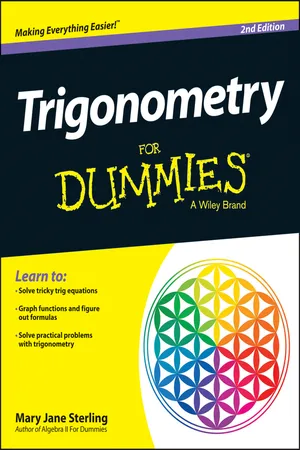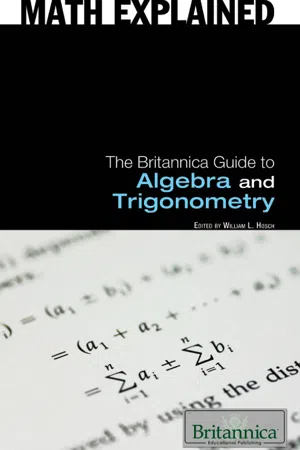Mathematics
Solving Trigonometric Equations
Solving trigonometric equations involves finding the values of the variables that satisfy the given trigonometric equation. This typically involves using trigonometric identities, solving for specific angles within a given range, and applying algebraic techniques to simplify and solve the equation. The solutions are often expressed in terms of exact values or as approximations using a calculator.
Written by Perlego with AI-assistance
Related key terms
Related key terms
1 of 4
Related key terms
1 of 3
7 Key excerpts on "Solving Trigonometric Equations"
- No longer available |Learn more
- Mary Jane Sterling(Author)
- 2014(Publication Date)
- For Dummies(Publisher)
complicate them), the different trig functions can be written many different ways. They almost have split personalities. When you're solving trig equations and trig identities, you're sort of like a detective working your way through to substitute, simplify, and solve. What answers should you expect when solving the equations? Why, angles, of course!Take, for example, one trigonometric equation: sin θ + cos2 θ = 1.The point of the problem is to figure out what angle or angles should replace the θ to make the equation true. In this case, if θ is 0 degrees, 90 degrees, or 180 degrees, the equation is true.If you replace θ by 0 degrees in the equation, you getIf you replace θ by 90 degrees in the equation, you getSomething similar happens with 180 degrees and all the other angle measures that work in this equation (there are an infinite number of solutions). But remember that not just any angle will work here. I carefully chose the angles that are solutions, which are the angles that make the equation true. In order to solve trig equations like this one, you have to use inverse trig functions, trig identities, and various algebraic techniques. You can find all the details on how to use these processes in Chapters 11 through 16 . And when you've got those parts figured out, dive into Chapter 17 , where the equation-solving comes in.In this particular case, you need to use an identity to solve the equation for all its answers. You replace the cos2 θ by 1 – sin2 θ so that all the terms have a sine in them — or just a number. You actually have several other choices for changing the identity of cos2 θ . I chose 1 – sin2 θ , but some other choices include and . Discover how to actually solve equations like this one in Chapter 17 .This example just shows you that the identity of the trig functions can change an expression significantly — but according to some very strict rules.Graphing for Gold
The trig functions have distinctive graphs that you can use to help understand their values over certain intervals and in particular applications. In this section, I describe the axes and show you six basic graphs.Describing graphing scales
You use the coordinate plane for graphing in algebra, geometry, and other mathematical topics. The x -axis goes left and right, and the y - H. Davies, H.G. Davies, G.A. Hicks(Authors)
- 2014(Publication Date)
- Routledge(Publisher)
Chapter 3Trigonometry
3.1 Introduction
Trigonometry is the branch of Mathematics that deals with the relationships between the sides and the angles of a triangle. Provided that a minimum of
are known about any triangle, the other unknown sides or angles can be calculated using trigonometrical methods.(i) 3 sides, (ii) 2 sides and 1 angle or (iii) 1 side and 2 angles Trigonometry is based on the trigonometrical ratios of sine, cosine and tangent, which are the ratios between the sides of a right-angled triangle. The values of these ratios depend upon the size of the angles, and do not depend on the size of the triangle.3.2 Trigonometric ratios
In Fig. 3.1 sides are given names with respect to the angle θ. The side opposite the right-angle (90°) is called the hypotenuse. The other two sides are named according to their position relative to the angle. The ratios are defined asFor a known angle the values of these ratios can be obtained from an electronic calculator. For example sin 40°=0.6428 can be obtained by entering 40 and pressing the sin key.Fig. 3.1Example 3.1 Find the lengths of the unknown sides in the steel bracket ABC shown in Fig 3.2 .Fig. 3.2Using with θ = 60° andMultiply both sides by 21.4:Using again with θ = 60° and h = 21.4cmExample 3.2 Fig 3.3 shows a voltage diagram for an electronic circuit. Calculate the phase angle ϕ between the two voltages.Fig. 3.3Note: ϕ = cos-1 0.5965 means that ϕ is an angle which has a cos of 0.5965. The value of ϕ can be obtained from the calculator by entering 0.5965 and pressing thecos−1key. cos-1 is the inverse of the cosine (see Section 3.15 ).3.3 Theorem of Pythagoras
This is an important theorem and is a useful alternative method of finding the third side of a right-angled triangle when the other two sides are known. In the right-angled triangle in Fig 3.4 the sides are labelled a, b, c according to the angles that they are opposite.Fig. 3.4- eBook - ePub
- Britannica Educational Publishing, William Hosch(Authors)
- 2010(Publication Date)
- Britannica Educational Publishing(Publisher)
RIGONOMETRYT rigonometry is the branch of mathematics concerned with specific functions of angles and their application to calculations. There are six functions of an angle commonly used in trigonometry. Their names and abbreviations are sine (sin), cosine (cos), tangent (tan), cotangent (cot), secant (sec), and cosecant (csc).Trigonometry developed from a need to compute angles and distances in such fields as astronomy, map making, surveying, and artillery range finding. Problems involving angles and distances in one plane are covered in plane trigonometry. Applications to similar problems in more than one plane of three-dimensional space are considered in spherical trigonometry.HISTORY OF TRIGONOMETRY
CLASSICAL TRIGONOMETRYThe word “trigonometry” comes from the Greek words trigonon (“triangle”) and metron (“to measure”). Until about the 16th century, trigonometry was chiefly concerned with computing the numerical values of the missing parts of a triangle (or any shape that can be dissected into triangles) when the values of other parts were given. For example, if the lengths of two sides of a triangle and the measure of the enclosed angle are known, the third side and the two remaining angles can be calculated. Such calculations distinguish trigonometry from geometry, which mainly investigates qualitative relations. Of course, this distinction is not always absolute: the Pythagorean theorem, for example, is a statement about the lengths of the three sides in a right triangle and is thus quantitative in nature. Still, in its original form, trigonometry was by and large an offspring of geometry. It was not until the 16th century that the two became separate branches of mathematics.ANCIENT EGYPT AND THE MEDITERRANEAN WORLDSeveral ancient civilizations—in particular, the Egyptian, Babylonian, Hindu, and Chinese—possessed a considerable knowledge of practical geometry, including some concepts that were a prelude to trigonometry. The Rhind papyrus, an Egyptian collection of 84 problems in arithmetic, algebra, and geometry dating from about 1800 BCE, contains five problems dealing with the seked . A close analysis of the text, with its accompanying figures, reveals that this word means the slope of an incline—essential knowledge for huge construction projects such as the pyramids. For example, problem 56 asks: “If a pyramid is 250 cubits high and the side of its base is 360 cubits long, what is its seked - eBook - ePub
- Seymour B. Elk(Author)
- 2016(Publication Date)
- Bentham Science Publishers(Publisher)
On the other hand, using radian measurement, the formulations such as sin x 2, sin, [or even (x+1) sin x], etc. are readily viable. One can even allow “messy” functions such as sin(sin x), etc. without confusion or ambiguity. This is in direct contradistinction to traditional trig courses which allow the alternation of trig and arc trig functions, but disallow trg(trg x) or arctrg(arctrg x). For example, ; however, sin(tan) was undefined, since the tangent function had to be applied to an angle ONLY, rather than a number. Using dimensionless numbers (i.e., radians) on the other hand,. Probably the most important use of trigonometry involves the solution of triangles; namely, given three of the five independent components (namely all three of the sides and two of the angles. Remember that the third angle is NOT independent in plane trigonometry. This is in contradistinction to the trigonometry of a sphere wherein the three angles are independent. See Section 2.6 below). The simplest way to do this is to develop two important relations between a trig function of one or more of the angles along with some of the sides in a general triangle. These designated as the Law of Sines and the Law of Cosines are proved as follows: LAW OF SINES: From any vertex of a triangle, say C, draw the“altitude”(the line segment from the vertex perpendicular to the opposite side - extended if necessary). (See Fig. 2.4-6). Fig (2.4-6). Triangle Used to Derive the Laws of Sines and Cosines. Call this length h. Note that the sides a and b are the hypotenuses of respective right triangles and thus: Eliminating h using method #2 of Section 2.3. yields: LAW OF COSINES: Label the parts into which side c has been divided by drawing h above as: x and c−x - Lawrence S. Leff, Christina Pawlowski-Polanish(Authors)
- 2021(Publication Date)
- Barrons Educational Services(Publisher)
STUDY UNIT IIITRIGONOMETRIC ANALYSIS
Passage contains an image
9 TRIGONOMETRYWHAT YOU WILL LEARN
Trigonometry means “measurement of triangles.” The study of trigonometry arose from the ancient need to understand the relationships between the sides and angles of triangles. With the development of calculus, trigonometry progressed from the study of ratios within right triangles to trigonometric functions that could be used to better represent the circular and repeating patterns of behavior that characterize a wide range of physical phenomena in the real world.This chapter progresses from considering acute angles in right triangles to a more general view of angles as rotations about the origin in the coordinate plane. By fixing the vertex of such an angle at the origin and keeping one side of the angle aligned with the positive x-axis, we can give meaning to trigonometric functions of angles greater than 90° and less than 0°.LESSONS IN CHAPTER 9•Lesson 9-1: Degree and Radian Measures•Lesson 9-2: Right-Triangle Trigonometry•Lesson 9-3: The General Angle•Lesson 9-4: Working with Trigonometric Functions•Lesson 9-5: Trigonometric Functions of Special AnglesLesson 9-1: Degree and Radian MeasuresKEY IDEAS
Angle measures can be expressed in units of degrees or in real-number units called radians. Degrees are based on fractional parts of a circular revolution. Radian measure compares the length of an arc that a central angle of a circle cuts off to the radius of the circle. The Greek letter θ (theta) is commonly used to represent an angle of unknown measure.MEASURING ANGLES IN DEGREES AND MINUTES
One degree, denoted as 1°, is of one complete revolution about a fixed point.Each of the 60 equal parts of a degree is called a minute- Boris Pritsker(Author)
- 2023(Publication Date)
- Chapman and Hall/CRC(Publisher)
6 Trigonometrical ExplorationsDOI: 10.1201/9781003359500-6Mathematics compares the most diverse phenomena and discovers the secret analogies that unite them.Joseph FourierTrigonometry is encountered in the most diverse problems of algebra, geometry, and calculus. It is a powerful and universal tool in getting links among math disciplines. There are numerous connections between them, expressed by trigonometric identities (you can find such identities in the appendix).In many cases trigonometry allows us to get appealing and efficient solutions compared to applications of pure geometrical or algebraic techniques. We will start with trigonometry “servicing” geometrical problems. PROBLEM 6.1. Of all the triangles with two sides of the given lengths, find the one with the greatest area.SOLUTION.There is no need even to make a diagram to solve this problem, as soon as we applied trigonometry. The area of a triangle can be determined by the formulaPROBLEM 6.2.S =, where a and b are the lengths of two sides, and γ is the angle between them. We know that1 2∙ a ∙ b ∙sin γfor any γ . Hence, the maximum area of a triangle will be attained forsin γ≤ 1, i.e., whensin γ= 1γ = 90 °, and it is. So, we conclude that of all the triangles with two sides of the given lengths the right triangle has the greatest area.S=m a x1 2∙ a ∙ bIn a right triangle, the hypotenuse is c and one of its acute-angle bisectors is. Find the legs.c 33SOLUTION.In the right triangle ABC (One of the possible approaches to this problem is applying algebraic techniques setting up a system of equations. Let’s see where it would get us.∠ A C B = 90 °), we haveA B = candA D =(AD is the angle bisector ofc 33∠ C A B).To simplify our calculations, denoteA C = x , B C = y ,andC D = z. Applying the Pythagorean Theorem to right triangles ACB and ACD- eBook - ePub
The Ellipse
A Historical and Mathematical Journey
- Arthur Mazer(Author)
- 2011(Publication Date)
- Wiley(Publisher)
y ) coordinates.Figure 5.2 Trigonometric functions as coordinates of a unit circle.The angle θ is sometimes expressed in radians and sometimes expressed in degrees. It is worth one’s effort to be able to use both units of measurement.5.1.2 TrianglesFor angles between 0˚ and 90˚ (from 0 to π /2radians), the trigonometric functions correspond to ratios of right triangles as illustrated in Figure 5.3 .Figure 5.3 Trigonometric functions as triangular ratios.The equivalence between the definitions in the preceding two tables is seen by noting the triangle formed between a point on the unit circle, the origin, and the point along the x axis given by the x coordinate of the original point. The ratios that define the trigonometric functions are the same for all similar triangles.5.1.3 ExamplesUsing the definitions, it is possible to determine the trigonometric functions for some values of θ . Examples are given below. These examples are the first entries into a trigonometric table that is further developed in subsequent sections.Example 5.1Determine the trigonometric for the value θ = π /4 rad (45˚).SolutionWhen the angle θ is π/4 rad, x = y along the unit circle (see Figure 5.4 ). With the assistance of the Pythagorean theorem, the values for x and y
Index pages curate the most relevant extracts from our library of academic textbooks. They’ve been created using an in-house natural language model (NLM), each adding context and meaning to key research topics.
Explore more topic indexes
Explore more topic indexes
1 of 6
Explore more topic indexes
1 of 4






